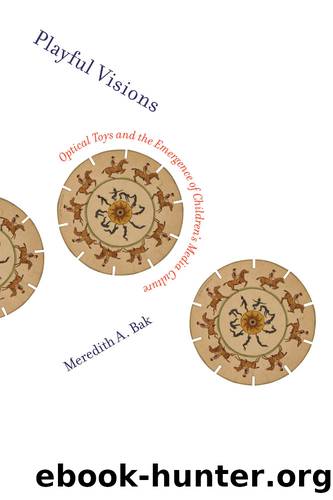Playful Visions by Meredith A. Bak

Author:Meredith A. Bak [Bak, Meredith A.]
Language: eng
Format: epub
Tags: Children; Childhood; Culture; Optical; Play; Playthings; Nineteenth-century; 19th Century; Cinema; Pre-Cinema; Moving Image; Illusions; Optical Illusions; Technology; Visual Technology; Visual Effects; Learning; Entertainment; Archival Research; Media Archaeology; Material Culture; Digital Natives; Screen Time; Children’s Media; Persistence of Vision; Pedagogy; Middle Class; America; United States; USA; Europe; Media culture; Rational Recreation; Child Consumers; Children and Consumption
Publisher: MIT Press
Conclusion
Within film theory, the notion of persistence of vision has long been a factor in characterizing the kinds of interactions viewers have with screen-based moving-image media, positioning the cinematic spectator as an active agent or a passive subject. Optical toys, as the means through which persistence of vision was introduced to young people, would help establish how children understood themselves as media audiences and part of how they came to understand vision itself. Within the nineteenth-century home, toys like the phenakistoscope and zoetrope facilitated the exercise and display of optical discernment: a way of performing white, middle-class sensibilities. Related childrenâs texts advanced hierarchies of the senses through social and moral allegories, such as the characterization of eyes as servants to the intellect. Such frameworks also helped yoke new modes of scientific authority to existing social values.
By presenting an illusion of motion, these toys highlighted the distinction between how a viewer perceives something and the actual object seen. They thus challenged the visual epistemology that had, until the nineteenth century, grounded the viewing subject. For children, however, the discourses of failure and deficiency were always already built into how they understood vision. Because vision was positioned as a learned developmental competency, scientific rhetoric that acknowledged its limits and its vulnerabilities did not necessarily produce anxiety, but instead formed the parameters within which subjectivity was constructed. The rational, disciplined subject could thus both delight in the moving image and maintain a sense of mastery by understanding how it worked. In this way, these toys recast vision not as an intuitive process, but as one that required conformity to a kind of training and refinement, which would be commensurate with a capitalist work ethic characterized by efficiency, focus, and intention.
Close examination of these toysâ material attributes and iconography imagines the kinds of social configurations that likely coalesced around them. Picturing these play spaces in turn helps better characterize the interactions that children had with these optical toys, not as entirely immersed in optical spectacle, but capable of dropping into and out of the illusion at will. Much like the museum visitors introduced at the beginning of this chapter, nineteenth-century optical play involved considerable trial and error, where children could choose to look or to look away. Nevertheless, such play was an opportunity to experience and internalize persistence of vision, and these toys were deployed to train childrenâs tastes and sensory habits. Optical play was an occasion for seeing and being seenâa pastime enjoyed during privileged leisure hours that enforced a distinct outlook on vision and social life overall. Persistence-of-vision toys paradoxically empowered viewers to understand the principles underlying their vision by playfully pointing out its limitations. These devices set into motion a visual regime that has continued into the contemporary childrenâs mediascape. At stake in this investigation, then, is an opportunity to explore the genesis of a long preoccupation with how young people are socialized into particular cultures of spectatorship, participation, and interactivity. Optical toys were not just the ludic devices that produced
Download
This site does not store any files on its server. We only index and link to content provided by other sites. Please contact the content providers to delete copyright contents if any and email us, we'll remove relevant links or contents immediately.
| Anthropology | Archaeology |
| Philosophy | Politics & Government |
| Social Sciences | Sociology |
| Women's Studies |
Cecilia; Or, Memoirs of an Heiress — Volume 1 by Fanny Burney(31333)
Cecilia; Or, Memoirs of an Heiress — Volume 3 by Fanny Burney(30934)
Cecilia; Or, Memoirs of an Heiress — Volume 2 by Fanny Burney(30889)
The Great Music City by Andrea Baker(21313)
We're Going to Need More Wine by Gabrielle Union(18073)
Bombshells: Glamour Girls of a Lifetime by Sullivan Steve(13108)
Pimp by Iceberg Slim(12931)
All the Missing Girls by Megan Miranda(12749)
Fifty Shades Freed by E L James(12451)
Norse Mythology by Gaiman Neil(11883)
Talking to Strangers by Malcolm Gladwell(11879)
Crazy Rich Asians by Kevin Kwan(8349)
Mindhunter: Inside the FBI's Elite Serial Crime Unit by John E. Douglas & Mark Olshaker(7834)
The Lost Art of Listening by Michael P. Nichols(6474)
Enlightenment Now: The Case for Reason, Science, Humanism, and Progress by Steven Pinker(6405)
Bad Blood by John Carreyrou(5769)
The Four Agreements by Don Miguel Ruiz(5511)
Weapons of Math Destruction by Cathy O'Neil(5037)
We Need to Talk by Celeste Headlee(4869)
